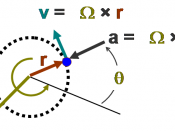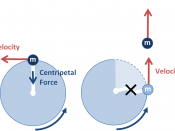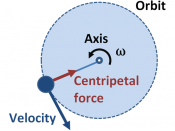Objective: The object of this lab was to experimentally analyze the uniform circular motion by its centripetal acceleration and force and then comparing it to the theoretical value.
Theory: An object moving in a uniform circular motion has a centripetal acceleration that when multiplied by the mass gives the centripetal force, which is the force that allows for circular motion.
An object moving in the uniform circular motion has centripetal acceration which is multiplied by the mass gi
Formulas
F = ma
F = mv
r
a = 4ÃÂ2Rf2
f = revolutions
t
Percent Error: Observed - Actual
Actual
Equipment
Cylindrical body
Weights
Vernier caliper
Meter stick
Rotator
Timer
Diagram
1. Set up circular motion apparatus.
2. Record the mass of the cylinder.
3. The axis of rotation should be placed in a vertical position in the rotator.
4. Rotate the apparatus till the pendulum bob is aligned with the indicator spindle.
5. For a total of five trials, measure the time it takes the cylinder to complete 50 revolutions.
6. Stop timer.
7. Record time.
8. Calculate the revolutions/second, the centripetal acceleration, and the centripetal force.
9. Attach a mass hanger to the apparatus and add weights till the pendulum bob is aligned with the indicator spindle. Record the mass.
10. Calculate the Fs, and the percent difference.
Tabulations
Mass m of cylinder = 0.4543kg
Table 1
Trials t (s) # of Revs (revs) f (revs/s)
1 32.0 50 revs 1.6rev/s
2 32.8s 50 revs 1.5 rev/s
3 35.7s 50 revs 1.4 rev/s
4 31.5s 50 revs 1.6 rev/s
5 31.7s 50 revs 1.6 rev/s
Total Suspended = 0.770kg
r = 0.168m
Table II
Fave (rev/s) a(m/s ) F (N) F (N) %Error
1.5 rev/s 14.9m/s 9.8N 7.5N -9.38
Calculations
f (revs/s)
Trial 1: f = 50.0...


